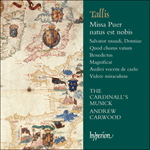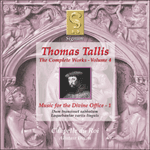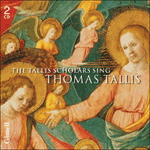The four-part Latin
Magnificat is perhaps Tallis’ earliest surviving composition. This piece sounds like the work of a young composer. Here we see Tallis learning the pre-Reformation style which comes to fruition in the antiphon
Salve intemerata virgo and which he was to develop further in
Gaude gloriosa. It is true that one has to forgive the jejune setting of ‘et sanctum nomen eius’ (which would merit a red-pen mark from a teacher of composition), some rather ungainly imitation (‘Sicut erat in principio’) and some unusual tessituras, especially in the contratenor part. But this is to miss the fact that Tallis has correctly assimilated the style, reducing his forces at appropriate moments, varying his duple and triple metres and highlighting the word ‘Abraham’ with caesuras and adding a nice harmonic turn at the cadence (which would later become a Tallis characteristic). He has also used a faburden as the basis of his composition. A faburden is the harmonization of an existing tune, in this case a version of the Mode I plainsong (used for the verses which Tallis did not set) which can be clearly heard acting as a cantus firmus throughout and most clearly at the beginning of each section, all of which start with three descending notes.
from notes by Andrew Carwood © 2014
Le
Magnificat latin à quatre parties—la plus ancienne œuvre, peut-être, de Tallis—semble le fait d’un jeune compositeur. Tallis s’y montre en train d’apprendre le style d’avant la Réforme, concrétisé dans l’antienne
Salve intemerata virgo et développé plus avant dans
Gaude gloriosa. Il est vrai qu’il faut pardonner le puéril «et sanctum nomen eius» (qui mériterait d’être biffé au crayon rouge par un professeur de composition), l’imitation assez gauche à «Sicut erat in principio» et quelques tessitures inhabituelles, surtout dans la partie de contre-ténor. Mais ce serait manquer combien Tallis a correctement assimilé ce style, réduisant les effectifs aux moments opportuns, variant les mètres binaire et ternaire, soulignant le mot «Abraham» avec des césures et ajoutant un joli détour harmonique à la cadence (l’une de ses futures griffes). Il a également fondé sa composition sur un faux-bourdon, c’est-à-dire sur l’harmonisation d’une mélodie existante, en l’occurrence une version du Mode I grégorien (utilisé pour les versets que Tallis ne mit pas en musique), qui sert clairement de cantus firmus de bout en bout—notamment, de manière très évidente, au début de chaque section, partant sur trois notes descendantes.
extrait des notes rédigées par Andrew Carwood © 2014
Français: Hypérion
Das älteste hier vorliegende Werk, bei dem es sich möglicherweise sogar um die älteste überlieferte Komposition Tallis’ handelt, ist das vierstimmige
Magnificat in lateinischer Sprache. Das Stück weist Merkmale eines jungen Komponisten auf. Hier kann man mitverfolgen, wie Tallis sich den vorreformatorischen Stil aneignet, der in der Antiphon
Salve intemerata virgo ausgereift zutage tritt und der in
Gaude gloriosa noch weiter entwickelt werden sollte. Es ist wahr, dass man über die etwas unzulängliche Vertonung der Worte „et sanctum nomen eius“ (die von einem Kompositionslehrer zurecht rot angestrichen würde), über unbeholfene Imitation („Sicut erat in principio“) und über ungewöhnliche Tonumfänge, insbesondere in der Contratenor-Stimme, hinwegsehen muss. Doch gleichzeitig sollte nicht übersehen werden, dass Tallis sich den Stil korrekt angeeignet hatte, seine Besetzung an entsprechenden Stellen reduziert und den Zweiertakt mit einem Dreiertakt abgewechselt, das Wort „Abraham“ mit Zäsuren hervorgehoben und eine schöne harmonische Wendung bei der Kadenz verwendet hatte (was später eines seiner Markenzeichen werden sollte). Zudem hatte er seiner Komposition den Faburden zugrunde gelegt. Ein Faburden ist die Harmonisierung einer bereits existierenden Melodie; in diesem Falle handelt es sich um eine Version des Cantus planus Modus I (der für die Verse eingesetzt ist, die Tallis nicht vertonte), der durchweg deutlich als Cantus firmus hörbar ist, insbesondere jeweils zu Beginn der einzelnen Abschnitte, die alle mit drei absteigenden Tönen anfangen.
aus dem Begleittext von Andrew Carwood © 2014
Deutsch: Viola Scheffel


 Tallis: Missa Puer natus est nobis & other sacred music
Tallis: Missa Puer natus est nobis & other sacred music Tallis: The Complete Works, Vol. 4
Tallis: The Complete Works, Vol. 4 Tallis: The Tallis Scholars sing Thomas Tallis
Tallis: The Tallis Scholars sing Thomas Tallis
